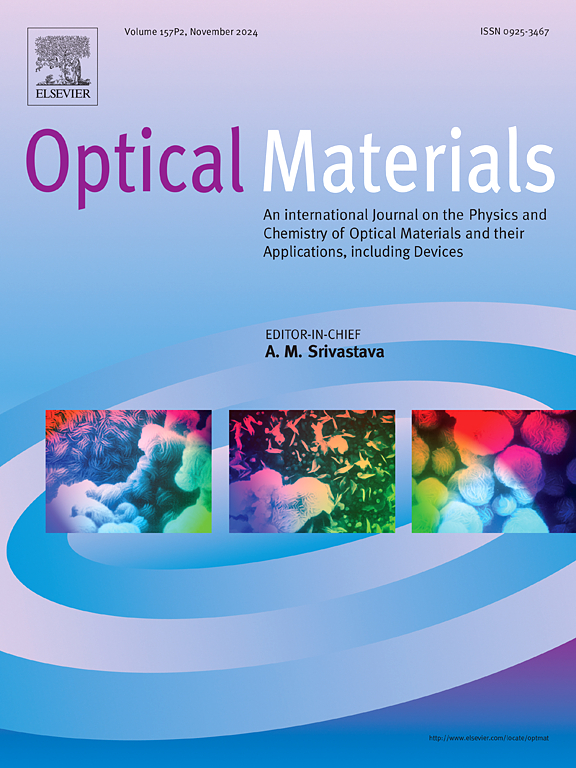Tailoring the FTIR, magnetic properties and neutron attenuation capacity of borosilicate glass: Role of Co3O4
IF 3.8
3区 材料科学
Q2 MATERIALS SCIENCE, MULTIDISCIPLINARY
引用次数: 0
Abstract
For Co3O4-reinforced borosilicate glasses, the effects of Co3O4 on the physical, FTIR, magnetic, γ-ray accumulation factors, and fast neutron attenuation capability were assessed. The nominal composition created using the traditional melt quench process was 15SiO2–20BaF2–20Na2O-(45-X)B2O3-XCo3O4, where X = 0.0 (Co-0.0) – 2.0 (Co-2.0) mol%. The Co-X samples amorphous condition as determined by XRD measurements. Specimen's density increased to 2.90 g/cm3 from 2.81 g/cm3. FTIR measurements verified that there was a conversion of [BO3] to [BO4] groups in the glass networks. As the Co3O4 concentration increased in the glass networks, the saturation magnetization decreased, while the coercivity increased. As photon energy rose, exposure and energy absorption accumulation factors got better. The glass sample designated as Co-2.0 demonstrated the lowest values of both relaxation length (λFNRCS) and half value layer (HVLFNRCS). The sample with code Co-2.0 has the best defense against radiation from γ-ray/fast neutrons. The findings verify that the Co-X glasses under investigation are suitable materials for applications involving magnetic and γ-ray/neutron shielding.
调整硼硅玻璃的傅立叶变换红外光谱、磁性能和中子衰减能力:Co3O4 的作用
对于 Co3O4 增强的硼硅玻璃,评估了 Co3O4 对物理、傅立叶变换红外光谱、磁性、γ 射线累积因子和快中子衰减能力的影响。采用传统熔体淬火工艺制作的标称成分为 15SiO2-20BaF2-20Na2O-(45-X)B2O3-XCo3O4,其中 X = 0.0 (Co-0.0) - 2.0 (Co-2.0) mol%。根据 XRD 测量,Co-X 样品为非晶态。试样的密度从 2.81 g/cm3 增加到 2.90 g/cm3。傅立叶变换红外光谱测量证实,玻璃网络中的[BO3]基团已转化为[BO4]基团。随着玻璃网络中 Co3O4 浓度的增加,饱和磁化率降低,而矫顽力增加。随着光子能量的增加,曝光和能量吸收累积系数也随之增加。代号为 Co-2.0 的玻璃样品的弛豫长度(λFNRCS)和半值层(HVLFNRCS)值都最低。代码为 Co-2.0 的样品对γ射线/快中子辐射的防御能力最强。研究结果证明,所研究的 Co-X 玻璃是一种适用于磁屏蔽和γ射线/中子屏蔽应用的材料。
本文章由计算机程序翻译,如有差异,请以英文原文为准。
求助全文
约1分钟内获得全文
求助全文
来源期刊

Optical Materials
工程技术-材料科学:综合
CiteScore
6.60
自引率
12.80%
发文量
1265
审稿时长
38 days
期刊介绍:
Optical Materials has an open access mirror journal Optical Materials: X, sharing the same aims and scope, editorial team, submission system and rigorous peer review.
The purpose of Optical Materials is to provide a means of communication and technology transfer between researchers who are interested in materials for potential device applications. The journal publishes original papers and review articles on the design, synthesis, characterisation and applications of optical materials.
OPTICAL MATERIALS focuses on:
• Optical Properties of Material Systems;
• The Materials Aspects of Optical Phenomena;
• The Materials Aspects of Devices and Applications.
Authors can submit separate research elements describing their data to Data in Brief and methods to Methods X.
 求助内容:
求助内容: 应助结果提醒方式:
应助结果提醒方式:


